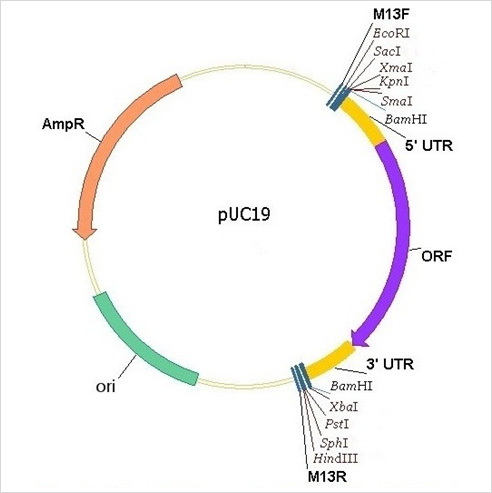In biotechnology, the targeted use of vectors capable of modification by artificially attaching genes of interest, GOI, is of great importance. With such vectors, it is possible to create recombinant DNA and then place it in the target organism, which can synthesize biologically active molecules generally uncharacteristic of the species. One of the most important biotechnological agents is pUC19, a circular double-stranded DNA molecule consisting of 2,686 pairs of nitrogenous bases (“Plasmid files,” n.d.). It is noteworthy that the design of this plasmid includes multiple restriction endonuclease sites, which allows the attachment of various DNA sequences. The AmpR gene ensures the resistance of the plasmid to the antibiotic Ampicillin, while the Ori site (pMB1) initiates replication, allowing the plasmid to reproduce. The plasmid’s purple region corresponds to an open reading frame with 5′ and 3′ UTR ends. All restriction sites (M13mp19) terminate the LacZ gene responsible for β-galactosidase expression.

The multiplicity of restriction sites makes it possible to include different GOIs in the construct. In particular, the EcoRI site (Escherichia coli) defines an endonuclease cut in the G…AATTC and CTTAA…G region (“Gene cloning,” 2021). On the other hand, HindIII (Haemophilus influenzae) defines the cut in the A…AGCTT and TTCGA…A region. Finally, GOI can be inserted into XmaI: C…CCGGG and GGGCC…C. Among others, such restriction sites make it possible to incorporate the recombinant human growth hormone gene, hGH, into the pUC19 plasmid. The central part of the coding sequence is inserted at the 250 bp position, while its hybrid version, pre(subC)::hGH, can be cloned in between the XbaI and BamHI sites, which is equivalent to a range of 417-423 bp (Özdamar et al., 2009). Subsequent cell culturing should be performed according to microbiological safety, sterility, and hermeticity requirements
In addition to antibiotic resistance to Ampicillin, the pUC19 plasmid has properties of scientific interest. For example, non-transformed cells will not grow on nutrient media with the presence of Ampicillin. In addition, due to the presence of the LacZ gene, the plasmid gains the ability to provide a blue-white selection for E.coli: blue-colored colonies, as a rule, do not have an insertion (Grooms, 2019). This means that cells carrying the hybrid plasmid form white colonies on medium with X-Gal because the insertion of foreign DNA into the polylinker disrupts the reading frame of the lacZ gene.
References
Gene cloning. (2021). Web.
Grooms, K. (2019). Selecting the right colony: The answer is there in blue and white. Promega Connections. Web.
Özdamar, T. H., Şentürk, B., Yilmaz, Ö. D., Çalık, G., Çelik, E., & Çalık, P. (2009). Expression system for recombinant human growth hormone production from Bacillus subtilis. Biotechnology Progress, 25(1), 75-84.
Plasmid files. (n.d.). Snap Genes. Web..
pUC19 Vector. (n.d.). SinoBiological. Web.
